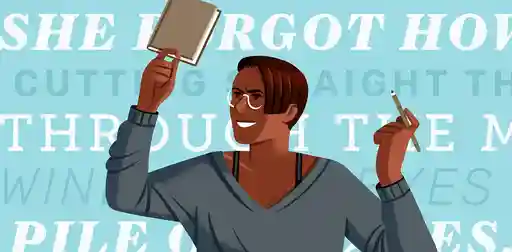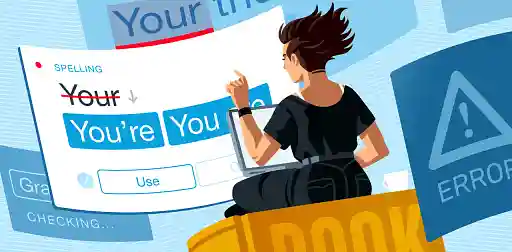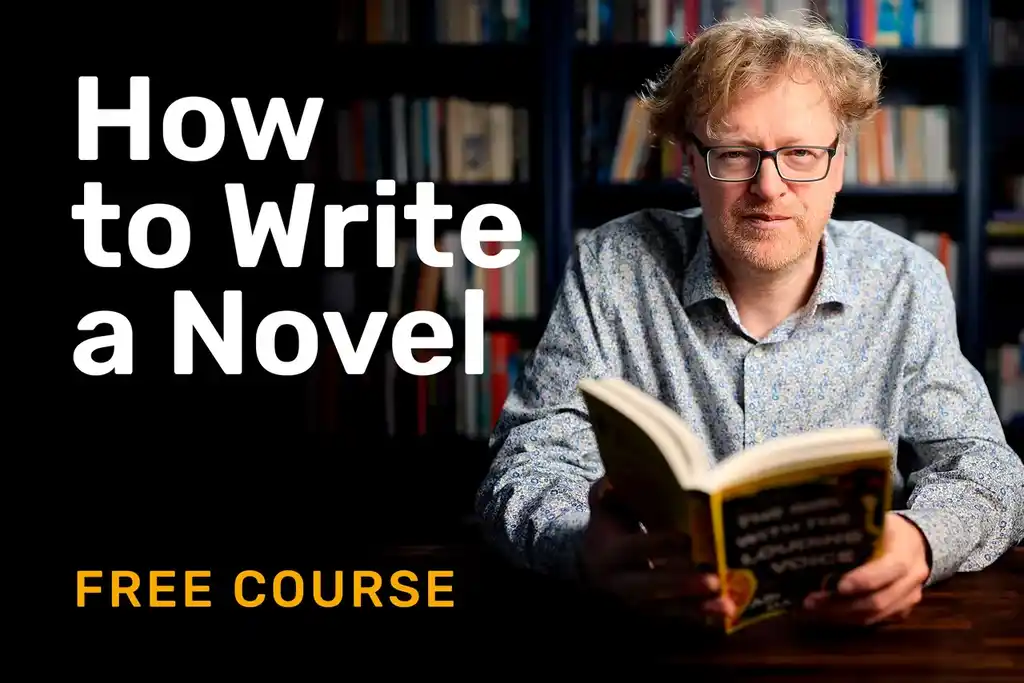Last updated on Oct 15, 2025
Six common writing mistakes by first-time authors, and how to fix them!
Martin Cavannagh
Head of Content at Reedsy, Martin has spent over eight years helping writers turn their ambitions into reality. As a voice in the indie publishing space, he has written for a number of outlets and spoken at conferences, including the 2024 Writers Summit at the London Book Fair.
View profile →Today, one of
 our most experienced editors on Reedsy shares some invaluable advice for first-time authors! Lourdes Venard specializes in crime fiction, science fiction, Young Adult, memoirs, and other nonfiction. She also teaches for the University of California, San Diego’s copyediting certificate program.
our most experienced editors on Reedsy shares some invaluable advice for first-time authors! Lourdes Venard specializes in crime fiction, science fiction, Young Adult, memoirs, and other nonfiction. She also teaches for the University of California, San Diego’s copyediting certificate program.
When it comes to writing, every writer is unique. But mistakes made by first-time authors are not as unique. In a very unscientific poll, I asked fiction editors which errors they come across the most often. Not surprisingly, the culprits were the same.
Below are the six most common writing mistakes identified by fiction editors, with simple fixes that can be done in the revision stage. I've also included a video at the bottom where three other editors discuss most of these mistakes — and more! — more in-depth. So if you're writing a book for the first-time, make sure you avoid all of these.
Wordiness
Wordiness can come from over-description, over-explanation, and redundant language. Those of us who are editors see this all the time in descriptions, especially in the use of adjectives and adverbs. Many first-time writers believe they need to bolster their nouns and verbs with adjectives and adverbs, but this often marks the writer as an amateur. Instead, writers should focus on using strong nouns and verbs. Take the simple phrase “a small river rushing by quickly.” A river that is rushing will naturally be doing so quickly, so eliminate the adverb.
The fix: When revising your manuscript, look through your descriptions—are there unnecessary words? Are you relying on adjectives and adverbs, rather than strong nouns and verbs? Look to cut as you revise.
“Telling”, rather than “showing”
The second most common writing mistake is “Telling,” rather than “showing.” This comes from explaining too much and not trusting the reader to understand — or not giving the reader the opportunity to fill in the spaces with his own imagination. A subset of this, as one editor said, is having characters discuss things in dialogue that no rational person would: “Did you know, Ian, that the agricultural sector in England was transformed by the Black Death, which arrived in England in 1348 and killed many laborers, and by the Hundred Years’ War, which was actually a series of conflicts waged from 1337 to 1453, as well as the Peasants’ Revolt of 1381?” If this sounds like a Wikipedia entry, it’s because it was indeed cobbled from Wikipedia—not from an actual conversation.
The fix: Dialogue can effectively impart information, but is it believable and natural? Use dialogue to move the story ahead, add tension between characters, and impart—but not dump—information. Break up the information into conversation-sized tidbits.
For more about "show don't tell" and how to avoid the telling mistake, watch this excellent presentation by editor Jim Spivey.
A laundry list of descriptions
A character is introduced and immediately a description, head to toe, is given; hair color, eye color, glasses, what the character is wearing are all covered in depth. The author may repeatedly mention those “liquid brown eyes.” As you can imagine, this is the type of writing mistake that will put off the reader.
The fix: It’s much more effective to describe a character through their behaviors, actions, body language, and dialogue. Here, crime fiction author Ian Rankin gives a description that skims over a character’s looks but manages to give us plenty (because our mind’s eyes fill in the rest): “He was twenty years younger than Rebus, and a stone and half lighter. A bit less gray in his hair. Most cops looked like cops, but Fox could have been middle management in a plastics company or Inland Revenue.”
Head-hopping
You want to keep your point of view to one protagonist (maybe two, if the story lends itself, as in a romance or a story with two strong characters whose paths cross, as in the award-winning All the Light We Cannot See by Anthony Doerr). To have more POVs dilutes the bond that a reader forms with the protagonist. Even worse is to have a point of view bounce from character to character in the same scene (we start out in the head of one character, only to hop into another character’s head).
The fix: It’s more powerful for the story to be told through the eyes of the main character, so make that your viewpoint. It may be more work to recast your story, but it will be the stronger for it.
Inappropriate dialogue tags
Many new writers have a fear of reusing the same dialogue tags—“said” or “asked”—and so editors see an abundance of incorrect dialogue tags: he yawned, she growled, he laughed. These dialogue tags mark the writer as inexperienced. Someone doesn’t “yawn,” “growl,” or “laugh” dialogue and, besides, they are clichéd ways of marking speech. Dialogue itself should show the reader whether a character is angry, happy, or sleepy.
The fix: Stick to “said” or “asked,” which become invisible to the reader, or avoid dialogue tags when it’s clear who is speaking. If you must indicate that a character has missed his naptime, then write, “he said, yawning.” Or even better, use a dialogue beat: “He stretched and yawned, putting down his coffee cup.”
Misplaced modifiers
This is one of the most common grammatical errors. These are phrases or clauses that are not clearly related to what follows. This not only makes for awkward sentences, but often unintentionally funny ones. For example: “After making some repairs, the pigs soon found their way to the fixed trough.” If pigs could fly—or repair their own troughs!
The Fix: Locate the modifier and relocate it to the appropriate place, or rewrite the sentence with the missing information. “After the farmer made some repairs, the pigs soon found their way to the fixed trough.”
Finally, there’s one other “fix” that may catch these and other errors. Read your manuscript aloud (some writers even go as far as reading it into a recorder, then playing it back). You’ll be surprised at what you find—portions that are dull, dialogue that goes on for too long, and awkward constructions that trip up the tongue. Simply delete or rewrite these!
More writing mistakes by three other Reedsy editors!
Watch this webinar recording, which lists twelve mistakes most first-time authors are prone to making. Three Reedsy editors go over all of them in depth and discuss how best to spot them while you rework your manuscript.
What other writing mistakes are authors prone to? And what is the best way to catch them? Let us know your thoughts, or any questions for Lourdes, in the comments below!










47 responses
pk kinnes says:
19/08/2015 – 17:21
I could not disagree more with the above regarding telling first-time authors to use only said or asked as dialogue tags. This is like telling a kindergartner to take up smoking and smoke six packs a day for the rest of his life! Said and asked may become invisible to some readers, but for those of us who have been reading for more than 50 years, reading the word said 15 or 16 times on one page is nothing short of suicide-inducing exasperation!
↪️ Jos Poortvliet replied:
20/08/2015 – 09:26
I think it isn't such bad advice. Many writers use it and it is fine. And they do note that if a dialogue is bouncing back and forth and you don't need any tag - skip 'em. That would work fine.
↪️ Ricardo Fayet replied:
20/08/2015 – 11:16
Personally, as a reader, I can get very annoyed at a writer using 100 different dialogue tags, with characters that growl, yawn, howl, sigh, sob, whine, etc. when they're actually just talking… "Said" has become transparent to me, so it doesn't interrupt the dialogue like these other tags do. Of course, readers all have different tastes and depending on your genre, you should research those tastes.
↪️ DENavarro replied:
18/10/2016 – 14:24
Correct.
↪️ Lourdes Venard replied:
20/08/2015 – 12:25
Using "said" can be overdone. Many writers try to get around that by using other dialogue tags, but those only serve to stop the reader momentarily. Another way of avoiding "said" is to use dialogue beats, small actions by each character (for example: Karen put her coffee cup down. "I'm not going.") or just by using strong dialogue in which it is apparent who is speaking.
↪️ DENavarro replied:
23/08/2015 – 03:43
pk, this may seem jarring at first, but trust me, it is so very true. These are great tips. Work it and understand it and you will see. Many of these tips were jarring to me at first until I realized the greatness of them. What is far more annoying to the average reader is to have things said with a chortle, snort, grunt, chuckle, and other endless superfluous decorations to dialogue that weaken it immeasurably. If the dialogue words themselves are powerful, they will carry an inherent descriptor, and you should show by ACTIONS how a person feels, not tell us they "growled" it out. See excerpt below: 8. Avoid endless synonyms for said. Effective writers know said is invisible and craft the dialogue to express the emotions. If you have to tell us that Andy said something angrily, then the words in the dialogue and the scene are not working. We should know by the scene and the spoken words themselves that Andy is angry. If the reader has already imagined a different emotion portrayed in the dialogue, when he gets to he said angrily it cuts against the scene, makes him go back and reread the dialogue with proper intent, and interrupts the flow of the story. The reader doesn’t know ahead what the tag line is going to say. Craft the words and the action to express the emotion. Not: Clara shook her head. “You did it to gain favor with her,” she accused. “That’s a lie,” Andy retorted angrily. Instead Try: Clara shook her head, pointed a stern finger in Andy’s face and said, “You did it to gain favor with her.” “No,” Andy said slamming his fist into his hand and pointing back, “That’s a lie.” In the second example we don't need to TELL the reader Clara accused we can see it in her actions. And we don't need to tell the reader Andy retorted angrily, we again see it in his actions. That's FAR MORE POWERFUL writing. 9. Avoid having characters “speak” with a sneer, grin, laugh, chuckle, growl, etc. We may sneer, or grin or chuckle before or after we speak. Avoid: He looked at his prisoner. “Tie him up,” he sneered. Instead: He sneered at his prisoner, “Tie him up.”
↪️ cheryl replied:
02/09/2015 – 20:22
Or better yet: Clara shook her head and pointed a stern finger in Andy’s face. “You did it to gain favor with her.” Andy slammed his fist into his hand and pointing back. “That’s a lie.”
↪️ DENavarro replied:
02/09/2015 – 23:43
You're right, but the illustration was also trying to point out how invisible "said" can be. However, when you can eliminate "said" all together, that is the best. I'll have to find a better sample.
↪️ Pat W replied:
18/03/2016 – 00:02
You don't always need dialog tags. He scratched his arm. "I think I have fleas." The action tells you who is talking.
Gavin Clements says:
19/08/2015 – 22:51
I am about to try my hand at writing a childrens/family book. I have the lead characters in mind and a setting and storyline/plot. However having never done this before I would appreciate any help or direction as to how to craft a story and any suggestions where I could get help will be gratefully received.
↪️ Lourdes Venard replied:
20/08/2015 – 12:15
Gavin, the Society of Children's Book Writers and Illustrators (http://www.scbwi.org/) has useful information, including podcasts and classes.
↪️ Gavin Clements replied:
21/08/2015 – 12:32
Thank you for the reply, I will have a look at that.
↪️ Ricardo Fayet replied:
21/08/2015 – 12:59
Of course, we have a lot of top-notch illustrators and children's book designers on Reedsy as well, so that's another place you can take a look at :)
↪️ Grace Padua replied:
22/08/2015 – 13:41
I prefer dialogue than narrative. Narration is telling, dialogue is action. Actual conversation in your story will put your reader into action breaking the "telling" and "explaining of the narrator.
↪️ Lourdes Venard replied:
24/08/2015 – 11:33
Yes, and dialogue tends to move at a quicker pace.
↪️ Cynthia Stoerkel replied:
13/01/2016 – 15:33
thank you so much! this information has been incredibly helpful. I am 58 years old, and writing a book has been on my bucket list since my teen years. just getting started.
Sally A Lundsten-Sanyang says:
21/08/2015 – 01:37
Yes, I read a lot of advice while constructing my manuscript(s)... including avoiding the over-use of 'said'. On that advice, I worked through the dialogue and removed 99% of 'said's and replaced with something else, often a description of the tone used for the sentence while trying not to (as Ricardo points out) irritate my reader. Writing evolves, so what is considered better, after all? Surely, if the word used is not considered properly by the writer in its effect we should use 'said'?
DENavarro says:
23/08/2015 – 03:47
Lourdes is right, she knows what she is talking about. If it seems jarring at first it is only because you have gotten used to the crooked handlebars and when they get straightened out it is hard to ride the bike until you get used to the right way again. Trust me, she didn't pull that out of the hat of opinion, it is a publishing industry standard for high quality work and any work that is published full of these errors or endless superfluous decorations to dialogue are rejected by most top editors. See my answer to pk below. Thanks Lourdes for knowing, understanding and sharing.
↪️ Lourdes Venard replied:
24/08/2015 – 11:35
Thanks, love the handlebar metaphor!
beth d. says:
23/08/2015 – 19:40
As a magazine editor (of non-ficition), I endorse this fully!!! The manuscripts I edit don't have protagonists, exactly, but to me, everything Lourdes says is spot-on. Misplaced modifiers make me crazy. Said is just fine, almost all the time. I find myself saying "show, don't tell" to writers all the time. I also try to assign word ranges rather than specific lengths because many writers will try to fiill out a story with needless extra words. My area is the visual arts (design, architecture, art, craft) so I'm much more lenient about adjectives as there's often less plot to carry the story! However, I say BRAVO to a well-stated, succinct set of writing guidelines!
↪️ Lourdes Venard replied:
24/08/2015 – 11:30
Thank you, Beth!
kb says:
24/08/2015 – 10:37
As a writer I appreciate this information, which is helping me to develop my mistakes in grammar which I'm not as good as I should be.
Lucius Pixel says:
25/08/2015 – 09:59
I think I am good with you here in Lemonaid https://nickyisdeep.wordpress.com/free-novel-2-in-progress/
Wolfenden Heys says:
27/08/2015 – 03:42
A good article, though I would disagree about the POV's. Check out George Martin's Game of Thrones series and Stephen King's Needful Things. Their stories rely on multiple protagonists. The POV's don't detract from the story, they add to them. I would also prefer less use of the word 'amateur' to describe a person who is making mistakes. It comes across as being elitist and is far too over-generalised...
↪️ Ricardo Fayet replied:
27/08/2015 – 10:36
Yes, I've read a few posts on viewpoint advice and every time I've thought "this is good advice, but George R.R. Martin does it differently". G.R.R.M. is unbelievably brilliant at having the reader empathize with 5-10 characters per book, and switching from chapter to chapter just makes you want to keep reading to know what happens to that character he just left on a cliff hanger. But as a general rule, I'd say that the more you focus your viewpoint on one character (or a limited number of them), the more the reader will be able to "connect" with that character. As one person commented on Reddit: "Game of Thrones is an epic, something like multiple novels woven into the same story. One character's story impacts the next, though they might not even meet. We engage one character for a while then drop that person for half a book. All the while we are wanting to know more but are instead forced to read the next book (chapter) in parallel. It is not a fundamental book from which we all ought to be learning basic viewpoint mechanics."
↪️ Wolfenden Heys replied:
27/08/2015 – 12:10
it just depends on what story you're trying to tell and what world you are trying to create. George Martin is one example but there are A LOT more authors who use more than one POV. I see what the author of this piece is trying to say, but in my opinion she's overstated the problem. But like I say other than that I agree with a great deal of her other points
↪️ Lourdes Venard replied:
28/08/2015 – 02:28
Ricardo made the point well. And George Martin and Stephen King have been writing for eons. These are two men who do play with the conventions of literature, and do it very well. My points were for newer writers, who often do multiple POVs in an attempt to show what one character cannot see (because that character was not in the scene) and not necessarily as a way to develop several characters. You are right, though, multiple POVs can indeed be done very well -- even by first-time writers, but it must be done with intention and thought.
Nikki Busch says:
31/08/2015 – 11:14
Great article, Lourdes! You've perfectly captured the major issues editors see when working with new authors. There are many authors, and not just first-timers, who could benefit from this wisdom.
Nikki Busch says:
31/08/2015 – 11:16
Great article, Lourdes! You've perfectly captured the issues editors often see when working with new authors. There are many authors, and not just first timers, who could benefit from your article.
↪️ Lourdes Venard replied:
31/08/2015 – 15:43
Thanks, Nikki!
Sally Asnicar says:
31/08/2015 – 11:22
Thanks for this useful article. Once writers become aware of these common errors, it's easier to avoid repeating them. I'm writing an article about overuse of glue words at the moment!
↪️ Lourdes Venard replied:
31/08/2015 – 15:43
I see "and then" or "suddenly" overused quite a bit. I'll be interested in reading your article.
ElgonWilliams Author says:
31/08/2015 – 13:01
There is little wrong with using action statements as if they are tags, as long as they are presented grammatically correct. Not only does this indicate the speaker in dialogue, but also it ties speaking to relevant action within a scene. This is a way of eliminating he said and she asked in a passage. If done well it can also advance the story, indicate emotion or disinterest within a character for the conversation - as in suppressing a yawn with the back of a hand. A good trick I have found for creating natural sounding dialogue is to write a scene almost in script format and then go back and feather in descriptions or actions in the scene.
↪️ Lourdes Venard replied:
31/08/2015 – 15:39
Yes, dialogue beats are also a good way to break up dialogue and can even enhance it, as with the yawning example you gave.
isolde100 says:
20/10/2015 – 16:33
I published my first novel last week, so I can address Ms. Venard's list of first-time author's writing mistakes. I agree with five of the items on the list, but the "head-hopping" mistake is different from point of view. When confronted with a first-time author's classic head-hopping mistake, the reader does not know who in a particular scene is thinking or saying something. That can be corrected easily. But to tell writers to keep their point of view to one or two protagonists throughout an entire novel is a bit too simplistic. Take War and Peace. In some scenes, you see things from the point of view of Prince Andrei; in other scenes, you are sitting inside the head of Pierre Bezukhov. In the first scene of War and Peace, Anna Pavlovna's soiree, you see through Anna's eyes, and so on. What makes War and Peace such an entertaining and memorable novel is that Tolstoy allows you to see many of the events and characters from different points of view! What should Tolstoy have done in the Battle of Borodino scenes, had he followed the advice to keep the point of view to one or two characters -- have Prince Andrei hiding behind a rock telling you and me what he sees and thinks? I can name a lot of well-written novels in which the author goes in and out of different character's heads. In Thomas Mann's "The Magic Mountain", Mann even switches to the "we" point of view, engaging the reader in a secret conspiracy with the author, as if "we" are privy to something the characters don't know, but will find out soon. I have had conversations with editors in which they have insisted that I abandon the third person point of view so common in fine works of literature in favor of limited third person point of view. For my novel, which has supernatural elements, the limited 3rd person works, but if I were to write a different novel, it would not work and it would be too limiting.
↪️ Ricardo Fayet replied:
20/10/2015 – 17:25
Hi Isolde, thanks for your thoughts on this. They certainly are in line with several comments we got through the social networks, and I agree with you: many fine works of literature (especially in the speculative fiction genre) have been written with several point of views. That said, I believe that limiting the viewpoint to one character is good advice because most authors are not Tolstoy, Mann, Tolkien or George R.R. Martin. For first-time authors, writing a novel through several points of view almost invariably tends to create head-hopping. Moreover, it is true that keeping your pov to one character helps the reader build a deeper connection with that character, while having several povs "dilutes" the reader's ability to do so. Now, once you understand this basic principle, if your novel absolutely needs to be told through several viewpoints, and if you are confident you will be able to avoid head-hopping mistakes, there is no reason why you can't have several character viewpoints. As Picasso used to say: "Learn the rules like a pro, so you can break them like an artist." Btw, here's another really good post by one of our Reedsy editors specifically on character viewpoint: http://blog.reedsy.com/show-dont-tell-write-from-a-character-viewpoint
Bec Nail says:
11/02/2016 – 04:07
This was very helpful, thank you! I completed my first book a few days ago. I'm proud of it and I want it to be a successful seller. This advice will help me clean it up before I send it to a professional editor.
↪️ Ricardo Fayet replied:
11/02/2016 – 10:52
Glad it helped, Bec! We have another good post on cleaning up a manuscript before sending it to a professional editor: http://blog.reedsy.com/how-to-revise-a-novel-step-by-step-guide And of course, when time comes to look for an editor, check out Reedsy: https://reedsy.com/editing/book-editor
Manuscriptable says:
23/02/2016 – 16:55
An excellent list reminiscent of college intro. to writing courses. All good points that new and old writers can learn from. As many have said, one must master the rules before one can break them artfully.
Bradley Tatro says:
25/04/2016 – 01:16
Thank you for these helpful tips.
↪️ Reedsy replied:
03/01/2017 – 17:18
I'm glad you enjoyed them!
Lewis Vinson says:
31/01/2017 – 10:38
Using exceptionally technical terms or big words. Most authors think that if they use high highfalutin words on their content, they can make their readers believe that they are way smarter compared to other writers. E-signature
copyedito says:
26/09/2018 – 06:50
Excellent article for the first time writers. I hope this would help a lot of the first time authors. The important thing, however, in writing a book is not let it sleep on the shelf for a long time. Regards, www.copyedito.com